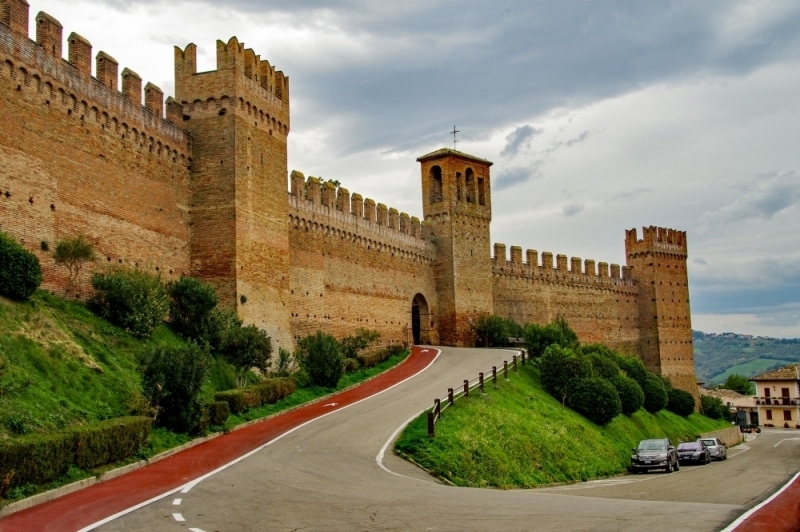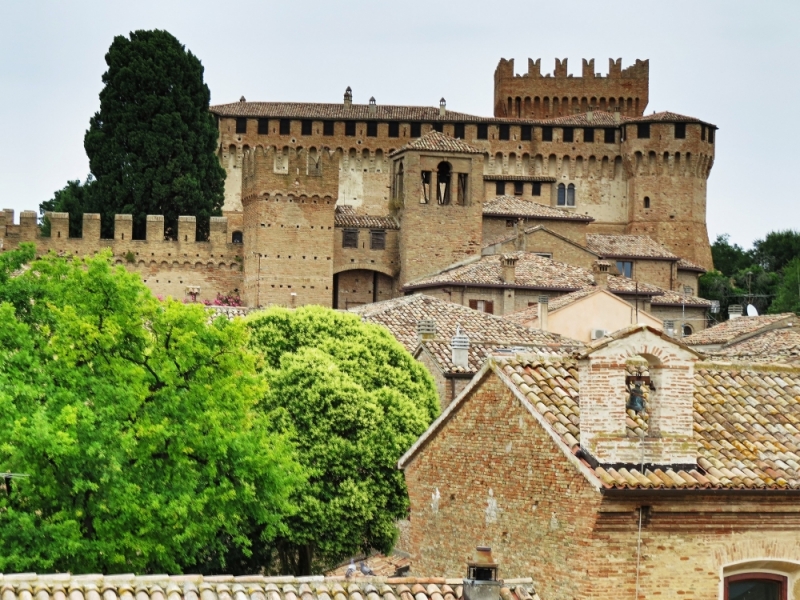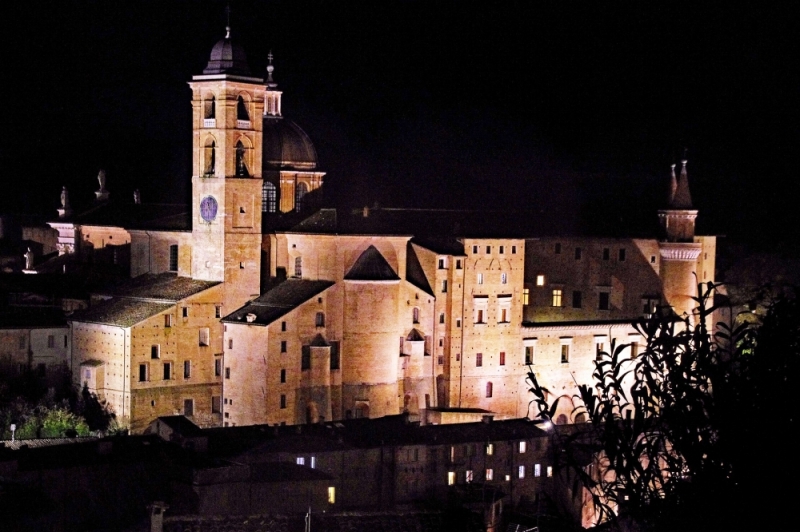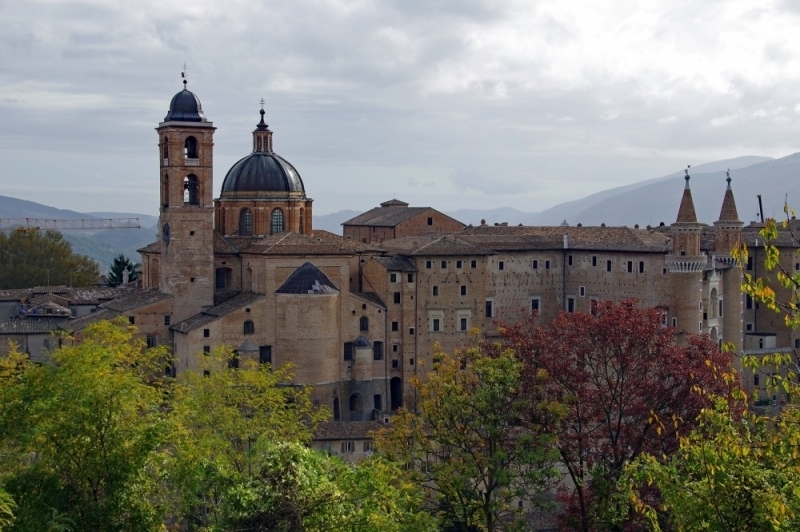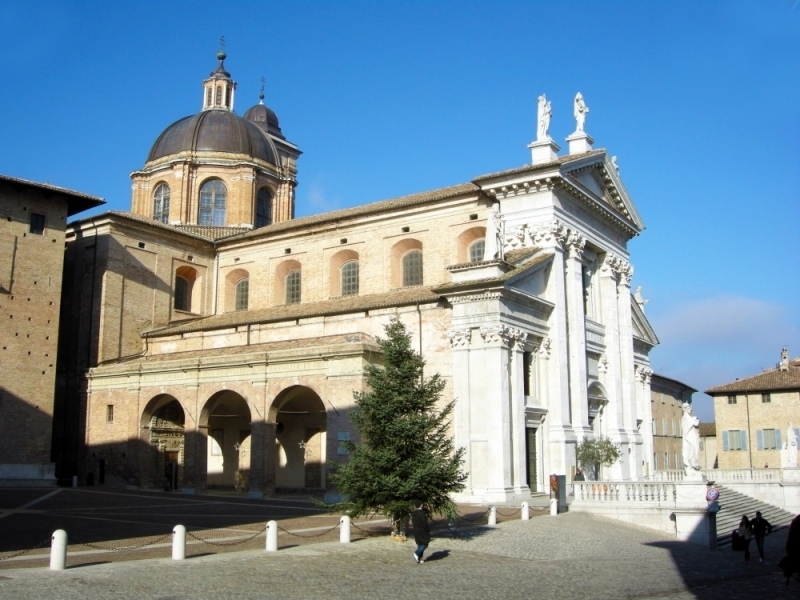The Marche region has a plurality of identities
The only Italian region to have retained the plural name, the Marche is an expression of a plurality of identity which is also expressed from a landscape point of view, the Marche is that region of Italy which develops between snow-capped peaks in winter and beaches of very fine sand in summer, capable of holding fifteen Blue Flags which certify the quality of the water, services and environmental management. But the Marche is also the cradle of Italian culture, a destination loved by pilgrims of the Christian religion, a region devoted to nature thanks to its two national parks and four regional parks, but above all a widespread open-air museum among villages and cities of art from the Renaissance era.
Gradara
Gradara . many tourists come to gradara to see the fortress and find themselves in a village rich in history.
the Rocca demaniale is the most eye-catching monument, it is certainly a place rich in history, it is possible to walk in the castle, on the walls but also on the drawbridge and in the elegant courtyard. the suggestive path called "walkways of ronda2 is today one of the main tourist attractions to admire the outside of the fortress in all its splendor, enjoy the panorama of the rolling hills and at the same time get lost beyond the horizon of the sea. Gradara palazzo rubini vesin is made up of a series of halls with important frescoes. Gradara's heritage of surprising naturalistic richness is "the wood of Faolo and Francesca," home to numerous botanical varieties, in the park you can witness the practices of birds of prey in flight.Finally, in the territory of Gradara there is the project le mura, an open-air museum itinerary of street art aimed at creating contemporary works of art.
Surely, however, the most interesting visit remains at the Albornoz Fortress which was built on the highest point of Mount San Sergio for defensive purposes in the second half of the fourteenth century. Today it houses the Bella Gerit Museum , while the space in front has become a public park. Before leaving the city, we advise you to take a stop in Gradara, a town known to lovers of literature. In fact, the love story between Paolo and Francesca took place in the castle of this village. This tour between legend and literature will leave you speechless. The town has been included among the most beautiful villages in Italy by the association of the same name and has been awarded, since 2004, the Orange Flag of the Italian Touring Club. The Castle of Gradara and its fortified village represent one of the best preserved medieval structures in Italy. Furthermore, the two walls that protect the fortress, the outermost of which extends for almost 800 meters, also make it one of the most impressive of the peninsula. Here many events are organized every year and it is possible, with the right permits and on time, even to get married.
Urbino The Pearl of the Renaissance
The city of Urbino has very ancient origins and the name Urvinum probably derives from the Latin Urvus (urvum is the curved handle of the plow). The ancient Urbinum Metaurense, so called then, was an important municipality in Roman times. At first it was occupied by the Goths, it was then conquered by Belisarius in 538, and then had its period of ascent with Liutprando. Around 1375, Antonio da Montefeltro, an important political and military figure, allied himself in 2376 with Florence and Milan and entered into an alliance with Gian Galeazzo Visconti. This link led to the recognition of his possessions in 1390 by Pope Boniface. The city had a period of wealth and rebirth both from a cultural and architectural point of view thanks to the Montefeltro family, who ruled (except for brief interruptions) until 1508. From 1508 to 1631, the duchy was presided over by the Della Rovere family, and then pass to the Church, when the city had its period of decline. In 1797 Urbino was conquered by the French, and then became part of the Roman Republic and the Italic Kingdom. It was occupied by Gioacchino Murat for a short time (March-May 1815) and was subsequently re-governed by the pontifical authority. Finally, in 1860, it became part of the Kingdom of Italy.
What to see in Urbino
Urbino is a city rich in history and art, nestled in the Marche hills. The city, characterized by a long brick wall and buildings made of sandstone, from a village became the "cradle of the Renaissance" thanks to the work of numerous artists, who surrounded Federico da Montefeltro, who wanted to create a city that represented fully the Renaissance. Walking through its alleys and admiring its majestic buildings, you will notice that the wishes of this man, an important figure for the city, were fulfilled. The historic center of Urbino, in fact, is today a UNESCO World Heritage Site.
We advise you to start your artistic-cultural tour starting from the Doge's Palace , which is not simply a palace, but a small fortified city, commissioned by Federico da Montefeltro, whose construction began in 1444. Federico, known for his refinement and elegance , he wanted to create a structure that surpassed other noble residences in Italy in beauty. Among the various masters who were involved in the creation of the building, Maso di Bartolomeo, Luciano Laurana and Francesco di Giorgio Martini should be mentioned. Enclosed in the heart of the Doge's Palace, there is a beautiful helical ramp. It was designed by Francesco di Giorgio, and is hidden inside the Circular Tower, which from Piazzale Mercatale led to the floor of the Urbino Theater. The staircase was created both to allow the Duke to reach the ducal stables on horseback and to check the work of the attendants in the stables. In the 19th century, the Sanzio Theater was built in the upper part thanks to the architect Vincenzo Ghinelli. The National Gallery of the Marche has approximately 80 rooms, in which paintings on wood and canvas, frescoes, sculptures, tapestries and many other works, which can be placed between the fourteenth and seventeenth centuries, are exhibited. The most evocative points are the “Facciata dei Torricini” and “Lo studiolo”, defined as a “treasure chest of beauty, refinement, perspective…”. Two masterpieces by Piero della Francesca are kept in the Duke's apartment: the Flagellation of Christ and the Madonna of Senigallia. There are also Portrait of a Gentlewoman by Raphael and Resurrection and The Last Supper by Titian. On the second floor, however, it is possible to admire works from the sixteenth and seventeenth centuries by artists such as Gentileschi, Barocci and Guerrieri. Inside this palace. a painting representing the emblem of the city is preserved, which is called precisely "the Ideal City", which reveals how Urbino has been a symbol of Italian and world art throughout the history.
In Urbino you cannot miss Raphael's birthplace , where his early works are kept. Located within the artisan district, this house represents Raphael's childhood, born on March 28, 1483. In 1873, the house became the property of the Raffaello Academy, which collected various works by the artist related to his life. On the ground floor it is possible to admire the workshop of his father Giovanni Santi, while on the first floor you will find both copies of Raphael's paintings and tributes from other artists. Visiting Raphael's bedroom, you will be able to admire closely the Madonna and Child, a work created in his youth in collaboration with his father. The Oratory of San Giovanni Battista has an external facade, restored in neo-Gothic style at the beginning of the 20th century, thanks to the project by Diomede Catalucci. Crossing the main door, you can admire the cycle of frescoes by the brothers Lorenzo and Jacopo Salimbeni da Sanseverino, exponents of the late Gothic period, dating back more or less to 1400. The entire wall of the apse is filled with the Crucifixion of Christ, while along the right side wall, it is possible to admire the Stories of the Life of San Giovanni Battista, completed in 1416. The latter is one of the greatest examples of floral or international Gothic in the Marche. On the left wall, however, the Madonna of Humility is painted.
The Duomo of Urbino is the main church of the city. Its rhyme construction dates back to 1021, it was later replaced by a church built by Francesc di Giorgi Martini. After the earthquake of 1789, the Cathedral was built thanks to Giuseppe Valadier, in the neoclassical style. Inside it is possible to admire two wonderful paintings by Federico Barocci: the Martyrdom of San Sebastiano and the Last Supper. The most evocative part of the chapel are the caves, where the works of the treasure of the Basilica of San Marco in Venice were kept during the Second World War. In the caves there is also the Corridor of forgiveness: which in the past was traveled to atone for sins, during Easter Monday. The Church of San Bernardino degli Zoccolanti is a Franciscan church located on a hill about 2.5 km from the center, from which it is possible to admire the city. It was built by order of Federico da Montefeltro after his death, to become the place of his burial and his successors. According to historians, this church is the result of the collaboration between Francesco di Giorgio Martini and Bramante. On the altar stands the "votive altarpiece of Federica" made by Piero della Francesca, now known as the "Pala di Brera".
Entertainment
If after touring the city, you want to take a break, there are characteristic restaurants where you can try the specialties of the city, such as La Locanda del Blasone Pizzeria, near Piazza della Repubblica, where you can taste typical dishes in a rustic setting. In the heart of the historic center, however, there is the Taverna degli Artisti, where you can eat genuine products at reasonable prices and, at the same time, admire the frescoes that decorate the walls. If you want to dine in a historical atmosphere, the Terrazza del Duca is the right place for you. You can try classic Marche cuisine at modest prices, overlooking the Doge's Palace. For nightlife lovers, there are numerous disco bars where you can spend the night, such as Bunker 83, the Art Cafè, where entertainment combines with art, the Bosom Pub, in the historic center, frequented by many students and the Q Club, one of the coolest clubs in the city.
Climate, Curiosities and Advice
Climate: The climate is warm and temperate. There is significant rainfall throughout the year, even in the driest month, such as July. The wettest month, however, is November. The hottest month is July, with an average temperature of 22.2 ° C, while the coldest is January, with an average temperature of 2.6 ° C.
Curiosity: when you visit Palazzo Ducale in Urbino, in a moment of tranquility, try to stand in the center of the external square of the building and sing a song: you will notice that your voice will seem amplified. In fact, the construction of the building allowed the Duke to look out from one of its windows and let the people reach his voice in a clear way.
Tips: before leaving the city, we advise you to taste two typical products, such as casciotta (a typical cheese made from cow's milk and sheep's milk) and cresciata sfogliata. Mouth-watering!


